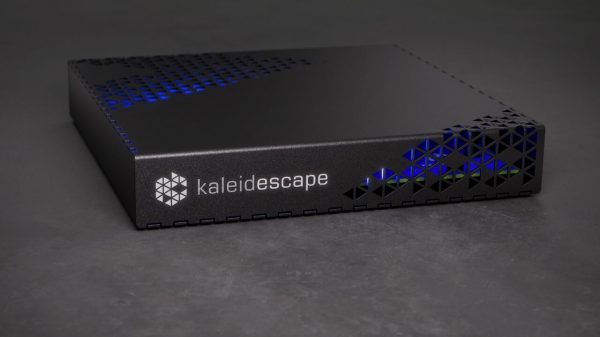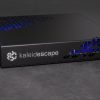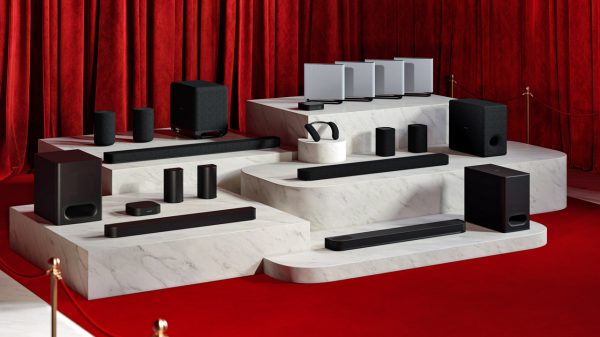Soundbars had a really good year in 2020; the ongoing COVID-19 pandemic kept movie theaters shuttered across all of N. America and consumers stuck at home looking for something positive to distract them from the reality of the situation. Disney+, Netflix, and Hulu became our movie theater and millions of consumers voted with their wallets; three rounds of stimulus money certainly helped as did 370 million people in the United States and Canada not spending on new cars or travel. The Sonos Arc, Sennheiser AMBEO, and Polk Audio React became very popular soundbars.
The AMBEO is $2,500 and building a 5.1 system around the Sonos Arc will run you $1,856 plus shipping.
But what about consumers looking for a complete wireless 5.1 soundbar system for under $1,600?
Enter the Enclave Audio CineHome PRO 5.1 wireless soundbar system.

The THX certified CineHome PRO/CineHub Edition bundle is powered by 11 Class D amplifiers, 14 custom-designed drivers with a 10-inch subwoofer, and the Enclave CineHub which connects to your television or sources and transmits the sound to the rest of the loudspeakers.
With support for Dolby Digital Plus, Dolby Digital, DTS Digital surround, Dolby Pro Logic II, eARC/ARC or Optical inputs and the ability to upgrade the system to a 5.4 setup, the Enclave Audio CIneHome PRO was off to a good start.
The front channels feature 6 full-range drivers with 3 tweeters in the front to help create a wide soundstage and produce a clear sounding midrange and crisp highs.
The two rear channels utilize a full range 3” driver and 1” tweeter in each rear speaker.

The powered subwoofer features a 10” woofer and is a sealed box design.
Just one cable to your TV is all that is required for setup. The CineHub is equipped with eARC and ARC for a simple setup process. Connect the HDMI cable provided to the ARC port of your TV, ensure the sound output is set to HDMI ARC and you’re ready to use the control app to configure the system.
What is HDMI-ARC?
The Enclave CineHub connects to your TV’s HDMI-ARC port. Most TVs have two to four HDMI ports, one of which has ARC, which stands for Audio Return Channel. The ARC port passes audio from your TV and connected devices, plus automatically pairs your TV remote to the Enclave CineHub.
Most TVs within the last 7 years have an HDMI ARC port, however, if one is not found you can use the optical audio connection from the Enclave CineHub to the optical port on your TV.
If you’re using sources like a Roku box or Blu-ray player, connect the HDMI cable to the TV and use the optical output to connect to the CineHub.
Can I use my TV remote?
To use your TV remote to control the CineHub for the most common features of daily use (Power On/Power Off, Volume Up/Volume Down, Mute) the CineHub must be connected to your TV’s HDMI-ARC input, and your TV needs to have HDMI-CEC enabled. HDMI-CEC has various names that are manufacturer dependent.
No Dolby Atmos or DTS-X?
The Enclave Audio CineHome PRO does not support Dolby Atmos or DTS:X. Even if you run your Blu-ray player, Roku, or video streaming service like VUDU, Disney+, or Amazon Prime through your HDTV to the CineHub.
Definitely disappointing when you consider that it is available through the AMBEO, and other soundbars below $2,000.
The design of the rear channels made it rather clear during installation that the system supports everything but those two surround formats.
Should that be a deal breaker for you? I would suggest that you’re making a huge mistake being hung up on one surround format.
I’m a huge supporter of Dolby Atmos (I was an early guinea pig for Dolby in their New York City theater), but I’m not sold on the soundbar approach with tiny drivers pointed at the ceiling from the same enclosure.
The Theory Audio Design 5.2.2 system that we just reviewed came with dedicated ceiling speakers that were full-range and could challenge most bookshelf loudspeakers under $2,000 so not exactly an even comparison.
Setup
The entire system was delivered in a very sturdy box that survived a few drops (well done UPS) based on the dents.
Enclave Audio get top marks for the packaging and easy installation. After removing each loudspeaker from the packaging, I realized that they were all neatly labelled to simplify installation and system setup with the app.
The loudspeakers are designed for wall-mounting (if that appeals to you) or placement on a media unit or credenza.
Aside from the rear surround speakers, I can’t imagine setting these up on a pair of dedicated stands.
After running an HDMI cable from my LG OLED HDTV to the CineHub, I installed the app and turned all of the components on.



The CineHome PRO does not come with a mic to perform a system calibration so you do need to pull out the tape measure and enter the distances between your seated position and all of the loudspeakers.
All of the loudspeakers need to plugged into the wall so please keep that in mind during installation.
The CineHub goes from silent to “volume on” almost immediately and I had to remind the kids to turn it down each night before they went to bed.
Nothing turns a consumer off more than a complicated installation setup that doesn’t work. People don’t want bells and whistles; they want a product that works out of the box, can be used by anyone in their home, and delivers excellent sound quality and reliability.
The Enclave Audio CineHome PRO delivers on all fronts in the aforementioned categories; although I do wish it had a more sophisticated calibration feature to account for any room acoustic issues that a customer might face.
The Sound & Competition
I was deeply impressed with the Theory Audio Design 5.2.2 home theater system, and my experience raised a lot of questions. Engineering a soundbar system that can deliver movie theater-quality dynamics and scale is a very difficult task.
Delivering state-of-the-art sound quality in a package for under $20,000 is a game changer; it also exposed just how large the performance gap is between soundbar home theater systems being sold for under $2,000 and this particular system.

You can certainly spend $20,000 on a dedicated 5.2.2 Dolby Atmos system and achieve great sound, but none of the systems we’ve heard (including a few selling for considerably more) can offer the same level of dynamics, detail, or tonal accuracy of the Theory Audio Design 5.2.2 system.
Don’t view this as a slight of the CineHome PRO. When you spend $20,000 on a soundbar system — it better deliver state-of-the-art performance.
At 1/10th the price, the CineHome PRO delivered more than respectable performance in comparison.
The biggest differences were the scale of the presentation, dynamics, and just how much closer the Theory 5.2.2 system brings you to a genuine movie theater experience.
Significantly closer with more even bass response.
The driver technology in the Theory 5.2.2 system is also state-of-the-art and the entire package is meant to be the audio configuration of a $100,000 home theater system.
Not exactly a fair fight.
Hagler vs Hearns
So let’s pick a fight with a soundbar that is almost $900 more expensive with support for Dolby Atmos and Hi-Res audio.
My review of the Sennheiser AMBEO is forthcoming but I must confess that it has taken longer to write as I feel a sense of ambivalence about it.
Have you ever wanted a component to just sound better than anything you’ve heard before in the category and feel a certain sense of smugness that you’re about to enjoy something that most people never will.
That was certainly the case with the Theory Audio Design 5.2.2 system but I never went to bed at night feeling that way about the AMBEO. I’m still puzzled by the experience.
So it should not surprise anyone that I preferred the Enclave Audio CineHome PRO to the AMBEO.
The CineHome Pro is a wireless home theater system that does not offer the technical capabilities of the AMBEO, but I enjoyed watching television and movies through it more. It’s less expensive, and surprisingly more engaging at moderate listening levels.
Not a single person in my family disagreed with my assessment that it offered greater dynamics, cleaner sounding dialogue, and a more engaging experience compared to the Sennheiser soundbar.
I’ve watched more than 100 movies and television programs through both the Sennheiser AMBEO and Enclave CineHome PRO and the results were fairly consistent.
This is the Way
It should surprise no one that I began my critical listening with multiple episodes of The Mandalorian; and not just because I have been obsessed with Star Wars since 1977. During my listening sessions with the Sennheiser AMBEO and Enclave Audio CineHome PRO home theater systems, I found myself rather underwhelmed by the AMBEO.

The AMBEO does a lot of things really well, but a $2,500 soundbar has to elevate the experience to another level and I never really felt that it did. It does deliver a very transparent sounding experience with a lot of detail; the spaciousness of the sound really depends on the content you feed it.
That being said, the AMBEO didn’t deliver the dynamic punch that I would expect from a product in this price range. Dialogue (with Dolby Atmos engaged) felt restricted to the front surface of the enclosure and never really engaged me.
When I disengaged the Dolby Atmos setting, the AMBEO opened up and became far more spacious sounding, but I had to raise the volume to become more immersed in the dialogue.
The CineHome PRO delivered dialogue that was more intelligible, better detail, and I found the experience more immersive. When I moved around the room and sat in a different chair, the off-axis performance of the CineHome PRO lost some of its dynamic punch.
Returning to my sofa that is 12 feet from the front of the screen, the soundstage solidified immediately and the dynamic impact of the soundtrack returned.
Watching the John Wick trilogy through both soundbars was truly fascinating; the AMBEO delivered a very wide sounding soundstage with a lot of detail (Dolby Atmos) and the impact of the shotgun blasts from his Benelli M4 combat shotgun had real impact.
The CineHome PRO delivered a more immersive experience that felt like Wick was in the room with us making us almost duck with each blast and wince from every cheesy line of dialogue.
The Criterion Collection reissue of The War of the Worlds features a new 4K digital restoration, with uncompressed monaural soundtrack. There is also a new 5.1 DTS-HD Master Audio soundtrack that breathes new life into this classic tale of a Martian invasion.
The CineHome PRO sold me with this movie that is not known for its engaging soundtrack; the spaciousness of the new 5.1 mix turned this B-movie into a really fun and scary evening for the kids.
The dialogue is rather putrid, but when the alien invaders decide to go full “Frank Castle” — the Enclave Audio soundbar delivered both impact and a different experience with this film from 1953.

Conclusion
I must confess that I was pleasantly surprised by the performance of the Enclave Audio CineHome PRO 5.1 wireless soundbar system. It delivers a very engaging and immersive surround sound experience without a lot of hassle. I do wish that it supported Dolby Atmos but that would have required a totally different design and there is something to be said about a wireless home theater setup that took less than 20 minutes to configure and start enjoying.
The vertical aspect of the front left/right speakers might make installation on some bookshelves impossible because of the height, but they really belong on a media unit on either side of your HDTV.
The app does need some refinement but it makes setup quite easy. I do still think the absence of a mic to do a proper system calibration is a mistake at this price point but nobody in my home complained even once in 3 months about the sound quality.
That might be the highest praise I can give it. My kids looked at me in horror as I packed it up.
For more information: enclaveaudio.com






































